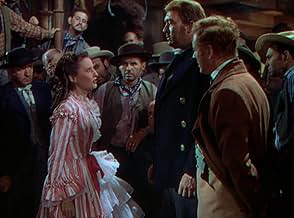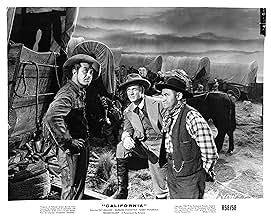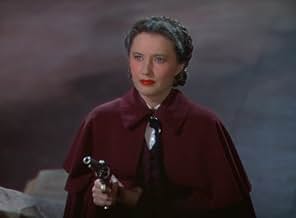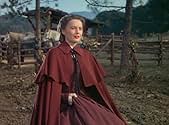IMDb रेटिंग
6.1/10
1.2 हज़ार
आपकी रेटिंग
अपनी भाषा में प्लॉट जोड़ेंEpic account of how California became a state, featuring a wagon train, the Gold Rush, a wicked saloon queen, and an evil profiteer.Epic account of how California became a state, featuring a wagon train, the Gold Rush, a wicked saloon queen, and an evil profiteer.Epic account of how California became a state, featuring a wagon train, the Gold Rush, a wicked saloon queen, and an evil profiteer.
John Alban
- Delegate
- (बिना क्रेडिट के)
George Anderson
- Miner
- (बिना क्रेडिट के)
Carl Andre
- Wagon Train Member
- (बिना क्रेडिट के)
Billy Andrews
- Boy
- (बिना क्रेडिट के)
फ़ीचर्ड समीक्षाएं
The movie is a stab at an epic western that simply fails to gel. The best part is the "moving west" scenes of wagon trains convoying across the open southwestern terrain. These achieve an epic feel that the dramatics unfortunately fail to duplicate. The screenplay itself is pretty crowded, telling the story of California's becoming a state, no less. From settlers to gold rush to saloons to political intrigue, the story is traced out mainly through Milland, Stanwyck, and Coulouris, with Fitzgerald as a salt-of-the-earth anchor.
Now, that might work, except director Farrow has little feel for the material. The various parts come across in rather limp, unexciting fashion. It's as if he's content to simply film the script without bringing its many conflicts to dramatic life. Thus, the drama is conveyed in words instead of characters. Then too, Oscar winner Milland appears either miscast or uninspired. His role really calls for a bigger personality than Milland's generally low-key wagon master. (He may have viewed a western as a comedown after his award winning role in The Lost Weekend.) Stanwyck is of course Stanwyck even though she's dolled-up to suit Technicolor filming and crowded around by the packed screenplay . Too bad the guy who could have enlivened the action remains in supporting background, namely, the commanding Albert Dekker (Pike).
Anyway, I guess I now know why this epic western remains so obscure, despite its Paramount pedigree and marquee cast.
Now, that might work, except director Farrow has little feel for the material. The various parts come across in rather limp, unexciting fashion. It's as if he's content to simply film the script without bringing its many conflicts to dramatic life. Thus, the drama is conveyed in words instead of characters. Then too, Oscar winner Milland appears either miscast or uninspired. His role really calls for a bigger personality than Milland's generally low-key wagon master. (He may have viewed a western as a comedown after his award winning role in The Lost Weekend.) Stanwyck is of course Stanwyck even though she's dolled-up to suit Technicolor filming and crowded around by the packed screenplay . Too bad the guy who could have enlivened the action remains in supporting background, namely, the commanding Albert Dekker (Pike).
Anyway, I guess I now know why this epic western remains so obscure, despite its Paramount pedigree and marquee cast.
This is a case where I feel like other reviewers have watched a different movie called "California" than the one I saw. The picture I enjoyed was a top-notch "A" western with an excellent cast, gorgeous Technicolor cinematography, spectacular California scenery, lively action, good pacing, and an intelligent, adult story.
At the top of the cast Ray Milland, Barbara Stanwyck, and Barry Fitzgerald, were at the peak of their careers. All three had garnered Academy Award honors within the past few years before "California's" early 1947 release. Milland was coming off his best actor award for Lost Weekend (1945), while Fitzgerald won best supporting actor for Going My Way (1944) and also got a best actor nomination for the same role! Stanwyck, a perennial bridesmaid of the Academy had received best actress nominations for Ball Of Fire (1941) and Double Indemnity (1944). "California" is a good showcase for their talents, each doing what he or she did best -- Ray the mild-mannered but hard-edged tough guy, Barry the lovable Irishman, and Barbara the hard broad who may or may not be hiding a heart of gold. Good support and stalwart villainy is provided by George Coulouris and Albert Dekker with a large cast of other supporting players and extras.
Some people can't picture Ray Milland as an appropriate western lead because of his British accent, even though it had became slight by the late 1940's when he had be living in the United States for two decades. But lots of people in the West would have had British and other foreign accents. Remember, we were and still are a nation of immigrants. Besides which Ray was imminently qualified to play westerns by his real life experiences. Having served several years in a crack British cavalry regiment in the 1920's, he was an expert horseman, and it shows by the way he sits a steed in "California". And he certainly knew which end of a gun the bullets came out of. A crack marksman, he helped his regiment win several prestigious shooting matches in his army days. Interestingly, he actually plays a professional trick shot artist in another western, Copper Canyon (see my review).
John Farrow's usual efficient direction and Eda Waren's editing keep the story moving along at a sharp pace. The script by Frank Butler and Theodore Strauss provides an intelligent, adult story with literate dialog. It gives an accurate, compelling picture of the California gold rush and the gold fever gripping immigrants to the Pacific Coast, as well as the movement for California statehood, a plot by the baddies for an armed overthrow of the government, and a torrid love triangle. As the intense, dark melodramas now known as film noir were at the height of their popularity when this western was filmed, the script endows the principles of the love triangle, Milland, Stanwyck, and Coulouris, with shady pasts. Milland's character, it turns out has deserted the Army. Stanwyck has been thrown out of every town she ever parked in for being -- shall we say charitably -- a floozy. Coulouris, villain enough as it is, has an even darker past as a slave ship captain. And he is now going slowly off his nut remembering the cries of the chained slaves and his fears they would rise up and get him. Dekker, occasionally a leading man or second lead, but more often a polished villain, is wasted here as Coulouris's former first mate and brutish henchman. Since Coulouris is always a bit over the top, perhaps "California" would have been better served if Dekker had had his role.
The script and Farrow's direction gives us just the right blend of dramatics and action. A rousing, old-time, full-bodied score by Victor Young helps move it along. Unlike other reviewers, I found the frequent outbursts of singing by both on-screen characters and an unseen chorus an asset to the picture, adding life and color and even historical accuracy. Some in this history challenged generation may not realize that in the days before people had television, computers, radio, movies, or even phonographs, they had to entertain themselves. They sang all the time, walking down the street, in their yards, in barber shops, at socials, around campfires (as in "California"), and in saloons. Even the meanest of saloons could usually scratch up some kind of band.
The costumes, sets, firearms, gun leather, lamps and other accouterments in "Callifornia" show an unusual degree of historical accuracy for a western of this era. No one has a repeating rifle, all muzzle loaders or crude breech loaders. Cap and ball revolvers are used in the closeups at least -- never mind they were not the exact models for 1849. You other gun nuts: in how many other movies have you seen a Hall breech loader? Good effort in this department.
Ray Rennahan, who did the camera work, gets credit for the unusually fine color cinematography, but with Natalie Kalmus on board as the Techniclor consultant, superb color was insured. The Technicolor Corporation required a consultant on every movie using their patented process, and Mrs. Kalmus, ex-wife of the inventor of Technicolor, was usually it. She was known around the studios as a bossy, irritating old dame, who interfered in set designs, camera set-ups, costume color and materials, prop selection, and virtually every other aspect of a color filming. She must, nevertheless, have known what she was doing. Every picture with her name on it will have muted, perfectly co-ordinated, precisely lighted, and generally superior color. After all, the studio technicians of the 1940's, as skilled as they were in black and white filming, had little experience with color. They actually needed a Natilie Kalmus, like it or not.
"California" in an A-1 Technicolor western, a visual treat and smooth, exciting entertainment from Hollywood's finest era.
At the top of the cast Ray Milland, Barbara Stanwyck, and Barry Fitzgerald, were at the peak of their careers. All three had garnered Academy Award honors within the past few years before "California's" early 1947 release. Milland was coming off his best actor award for Lost Weekend (1945), while Fitzgerald won best supporting actor for Going My Way (1944) and also got a best actor nomination for the same role! Stanwyck, a perennial bridesmaid of the Academy had received best actress nominations for Ball Of Fire (1941) and Double Indemnity (1944). "California" is a good showcase for their talents, each doing what he or she did best -- Ray the mild-mannered but hard-edged tough guy, Barry the lovable Irishman, and Barbara the hard broad who may or may not be hiding a heart of gold. Good support and stalwart villainy is provided by George Coulouris and Albert Dekker with a large cast of other supporting players and extras.
Some people can't picture Ray Milland as an appropriate western lead because of his British accent, even though it had became slight by the late 1940's when he had be living in the United States for two decades. But lots of people in the West would have had British and other foreign accents. Remember, we were and still are a nation of immigrants. Besides which Ray was imminently qualified to play westerns by his real life experiences. Having served several years in a crack British cavalry regiment in the 1920's, he was an expert horseman, and it shows by the way he sits a steed in "California". And he certainly knew which end of a gun the bullets came out of. A crack marksman, he helped his regiment win several prestigious shooting matches in his army days. Interestingly, he actually plays a professional trick shot artist in another western, Copper Canyon (see my review).
John Farrow's usual efficient direction and Eda Waren's editing keep the story moving along at a sharp pace. The script by Frank Butler and Theodore Strauss provides an intelligent, adult story with literate dialog. It gives an accurate, compelling picture of the California gold rush and the gold fever gripping immigrants to the Pacific Coast, as well as the movement for California statehood, a plot by the baddies for an armed overthrow of the government, and a torrid love triangle. As the intense, dark melodramas now known as film noir were at the height of their popularity when this western was filmed, the script endows the principles of the love triangle, Milland, Stanwyck, and Coulouris, with shady pasts. Milland's character, it turns out has deserted the Army. Stanwyck has been thrown out of every town she ever parked in for being -- shall we say charitably -- a floozy. Coulouris, villain enough as it is, has an even darker past as a slave ship captain. And he is now going slowly off his nut remembering the cries of the chained slaves and his fears they would rise up and get him. Dekker, occasionally a leading man or second lead, but more often a polished villain, is wasted here as Coulouris's former first mate and brutish henchman. Since Coulouris is always a bit over the top, perhaps "California" would have been better served if Dekker had had his role.
The script and Farrow's direction gives us just the right blend of dramatics and action. A rousing, old-time, full-bodied score by Victor Young helps move it along. Unlike other reviewers, I found the frequent outbursts of singing by both on-screen characters and an unseen chorus an asset to the picture, adding life and color and even historical accuracy. Some in this history challenged generation may not realize that in the days before people had television, computers, radio, movies, or even phonographs, they had to entertain themselves. They sang all the time, walking down the street, in their yards, in barber shops, at socials, around campfires (as in "California"), and in saloons. Even the meanest of saloons could usually scratch up some kind of band.
The costumes, sets, firearms, gun leather, lamps and other accouterments in "Callifornia" show an unusual degree of historical accuracy for a western of this era. No one has a repeating rifle, all muzzle loaders or crude breech loaders. Cap and ball revolvers are used in the closeups at least -- never mind they were not the exact models for 1849. You other gun nuts: in how many other movies have you seen a Hall breech loader? Good effort in this department.
Ray Rennahan, who did the camera work, gets credit for the unusually fine color cinematography, but with Natalie Kalmus on board as the Techniclor consultant, superb color was insured. The Technicolor Corporation required a consultant on every movie using their patented process, and Mrs. Kalmus, ex-wife of the inventor of Technicolor, was usually it. She was known around the studios as a bossy, irritating old dame, who interfered in set designs, camera set-ups, costume color and materials, prop selection, and virtually every other aspect of a color filming. She must, nevertheless, have known what she was doing. Every picture with her name on it will have muted, perfectly co-ordinated, precisely lighted, and generally superior color. After all, the studio technicians of the 1940's, as skilled as they were in black and white filming, had little experience with color. They actually needed a Natilie Kalmus, like it or not.
"California" in an A-1 Technicolor western, a visual treat and smooth, exciting entertainment from Hollywood's finest era.
California really disappointed me. It is without question Barbara Stanwyck's least shown Western ( and the only one that eluded me). The problem is not that it is bad movie ( it isn't), it is that Barbara ( Lily) is wasted. Barbara in westerns from the beginning ( Annie Oakley) until the end ( The Big Valley) is the reason to watch. Not here: It is. Ray Milland's ( Jonathan Trumbo) Film all the way, and he dominates the movie. One major plus is the print. I am willing to bet that Universal remastered the movie because of how crystal clear the print is. I still cannot get over how disappointed I was in this movie. I give it 5/10 stars. All for Milland and the quality of the print.
If back in 1946 when California the movie was made, let alone in the 1840s when California came to the USA via the Mexican Cession, people knew what a sprawling entity California would become, the idea of a separate California country that George Coulouris wanted to have might have been the idea might have been sold. As it is now California has about 9% of the House of Representatives and a population and budget bigger than most countries.
But we're back in the year of 1849 when trail guide Ray Milland is guiding a wagon train to the Pacific, to the newly acquired lands of the Mexican War. He's reluctantly allowed Barbara Stanwyck to travel with Barry Fitzgerald on the train. Stanwyck's been given a heave-ho out of town similar to what Claire Trevor got in Stagecoach. The two of them are mighty attracted to each other, but Milland thinks she's cheap and Stanwyck thinks he's stuck up.
It tears it for Milland when Stanwyck upon reaching California takes up with George Coulouris, a powerful, rich, and mysterious former sea captain who gained his fortune in the slave trade. He's a mean one to cross and his ambitions include nothing less than carving out a separate California Empire with himself as head.
So the political mixes with the personal as Milland fights Coulouris for California and Stanwyck.
California was a big budget item for Paramount that year, the only thing it lacked was Cecil B. DeMille directing it. The film was shot on location in Sedona, Arizona in gorgeous technicolor, courtesy of Ray Rennahan. You have to remember that Milland had won the Best Actor Oscar for The Lost Weekend the previous year and Paramount was now trying to take advantage of that.
Stanwyck loved making westerns and it sure shows here. This was Ray Milland's first starring western, he'd do a few more and not bad ones either. Fitzgerald steals the show of course in every scene he's in as the wise grape grower who sees vineyards in the Napa Valley as part of California's future.
The whole thing is nicely directed by John Farrow. And of course Coulouris will creep you out with his brand of villainy. Catch it when it's broadcast.
But we're back in the year of 1849 when trail guide Ray Milland is guiding a wagon train to the Pacific, to the newly acquired lands of the Mexican War. He's reluctantly allowed Barbara Stanwyck to travel with Barry Fitzgerald on the train. Stanwyck's been given a heave-ho out of town similar to what Claire Trevor got in Stagecoach. The two of them are mighty attracted to each other, but Milland thinks she's cheap and Stanwyck thinks he's stuck up.
It tears it for Milland when Stanwyck upon reaching California takes up with George Coulouris, a powerful, rich, and mysterious former sea captain who gained his fortune in the slave trade. He's a mean one to cross and his ambitions include nothing less than carving out a separate California Empire with himself as head.
So the political mixes with the personal as Milland fights Coulouris for California and Stanwyck.
California was a big budget item for Paramount that year, the only thing it lacked was Cecil B. DeMille directing it. The film was shot on location in Sedona, Arizona in gorgeous technicolor, courtesy of Ray Rennahan. You have to remember that Milland had won the Best Actor Oscar for The Lost Weekend the previous year and Paramount was now trying to take advantage of that.
Stanwyck loved making westerns and it sure shows here. This was Ray Milland's first starring western, he'd do a few more and not bad ones either. Fitzgerald steals the show of course in every scene he's in as the wise grape grower who sees vineyards in the Napa Valley as part of California's future.
The whole thing is nicely directed by John Farrow. And of course Coulouris will creep you out with his brand of villainy. Catch it when it's broadcast.
In this movie John Farrow shows the great director he was. The camera work is exceptional, with scenes lasting more than 4 minutes filmed in just one take!. Although there are several of this scenes in the movie, there are other aspects to comment also. The actor's direction is superb, obtaining the most of all of them, in particular the performance of George Colouris (the villain) is outstanding. Moreover, this is not the typical western; the plot shifts unexpectedly from the line one assumes it will follow, to a very different one, and the movie maintains its coherence perfectly. A real gem.
क्या आपको पता है
- ट्रिवियाThis film was in production November 1945-February 1946, and bears a 1946 copyright statement, and was released in January 1947.
- गूफ़A number of the pistols used by characters appear to be cartridge revolvers, rather than cap-and-ball.
- भाव
Lily Bishop: You may think you're pretty high and mighty, Trumbo. But let me tell you this... if I live long enough, and I will, I'm going to pull you down off that fancy horse of yours and shove your face in the muck - so help me!
- कनेक्शनFeatured in बात करने के लिए कुछ (1995)
टॉप पसंद
रेटिंग देने के लिए साइन-इन करें और वैयक्तिकृत सुझावों के लिए वॉचलिस्ट करें
- How long is California?Alexa द्वारा संचालित
विवरण
- चलने की अवधि1 घंटा 37 मिनट
- रंग
- पक्ष अनुपात
- 1.37 : 1
इस पेज में योगदान दें
किसी बदलाव का सुझाव दें या अनुपलब्ध कॉन्टेंट जोड़ें



































